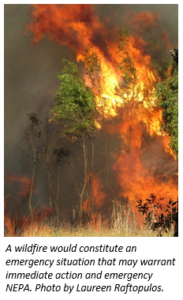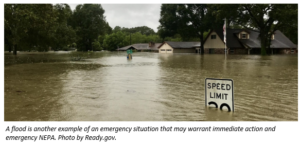As NEPA planners know all too well, NEPA is a process that takes time – though it should take less than one year for an EA and less than two years for an EIS! In some rare instances, however, emergent issues necessitate urgent agency action that cannot await the months or even years needed to complete the normal NEPA process. To account for these rare instances, on September 14, 2020, the Council on Environmental Quality (CEQ) updated and replaced previous CEQ guidance to help agencies comply with NEPA during emergencies. In this blog, I highlight what NEPA planners need to know about when and how to invoke NEPA during emergencies.
When Do I Apply the Emergency NEPA Guidance?
First, before even thinking about “but wait, where’s our NEPA document?”, agencies must not
If sufficient time does not exist, then NEPA planners can apply alternative NEPA arrangements for a wide range of proposed actions in emergency situations “including natural disasters, catastrophic wildfires, threats to species and their habitat, economic crisis, infectious disease outbreaks, potential dam failures, and insect infestations.”
It is important to note that the CEQ guidance does not (and legally cannot) exempt any activities from NEPA, and that the use of alternative arrangements for NEPA compliance can only be used for the actions necessary to respond immediately to the impacts of an emergency. Conversely, long-term actions needed to respond to an emergency (e.g., recovery actions) remain subject to the regular NEPA process.
How Do I Apply Alternative NEPA Arrangements?
The guidance covers actions that would result in significant impacts (preparation of an EIS) or less than significant or uncertain impacts (preparation of an EA). The sidebar graphic summarizes the steps a NEPA planner should take to determine the appropriate level of alternative NEPA arrangements for their emergency action. Summaries of the two alternative NEPA arrangements follow. Remember, alternative arrangements do not waive the requirement to comply with NEPA, but rather establish an alternative means for NEPA compliance.
For Significant Impacts
In emergency situations when an agency proposes to take action that would normally result in the potential for significant environmental impacts, the federal agency taking the action should consult with the CEQ about alternative arrangements for just those actions necessary to control the immediate impacts of the emergency. Other related but non-emergency actions remain subject to normal NEPA review.
Contact the CEQ to develop alternative arrangements at (202) 395-5750 (FYI, I just called the number and spoke to a live person – they’re there to help!). In consultation with the CEQ, the agency will develop alternative arrangements. The CEQ will then provide documentation detailing the alternative arrangements. Also, engaging other resource and regulatory agencies during development and implementation of alternative arrangements can facilitate meeting other compliance requirements. Factors to address when requesting and designing alternative arrangements include the:
- Nature and scope of the emergency;
- Actions necessary to control the immediate impacts of the emergency;
- Potential adverse effects of the proposed action;
- Components of the NEPA process that the agency can follow and provide value to decision making (e.g., coordination with affected agencies and the public);
- Duration of the emergency; and
- Potential mitigation measures.

When agencies are considering emergency actions with less than significant or uncertain impacts, NEPA planners can prepare a concise, focused EA (yes, even more concise and more focused than we do normally!). Alternative arrangements, as outlined at 40 CFR 1506.12, do not apply because the environmental impacts are not expected to be significant. Some agencies have developed specific procedures for preparing EAs for emergency actions (e.g., the Department of Interior here).
An agency can prepare a concise and focused EA in a short time in those situations where:
- There is not statutory exemption from NEPA;
- Use of a Categorical Exclusion is not available;
- An existing NEPA analysis does not cover the proposed emergency action; and,
- The potential impacts of the proposed emergency response action(s) are not likely to be significant.
The resulting concise and focused EA should cover the following areas in a succinct manner:
- The purpose and need for the emergency action(s);
- Alternatives;
- The description of environmental impacts; and,
- A list of agencies and persons consulted.
An example purpose and need for an action would be “This agency is preparing to erect a temporary emergency response facility to replace facilities destroyed by contamination to facilitate relief efforts in an effort to minimize adverse health conditions.”
It is also a recommended time and space saver to aggressively incorporate, by referencing prior reports, data, analyses, and other information in the EA. The agency should be clear and concise about its conclusions and their bases for their determination. As part of the effort, agencies must continue to notify and inform the public and relevant federal, state, tribal, and local agency representatives to the extent practicable during and after the emergency.
Finally, remember that related but non-emergency actions remain subject to normal NEPA review. As part of the follow-on NEPA review the agency should conduct public engagement and notification.
Summary
If you are ever faced with supporting the immediate recovery or response actions for an emergency, review the provided decision tree and take the appropriate steps for your scenario, and coordinate with your agency environmental planners and attorneys, and if needed, the CEQ. And, of course, you can always call us here at Scout to help you navigate the emergency NEPA arrangements. Finally, if you never need to use emergency NEPA, at the very least, keep preparing concise NEPA documents to foster excellent actions!
Scout Environmental is ready to help with your Emergency NEPA needs. Please contact us at hello@scoutenv.com
Information from the graphic above is derived from CEQ’s Emergencies and NEPA Guidance, September 14, 2020.














